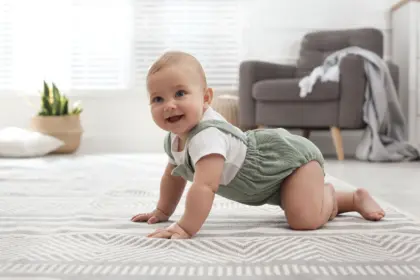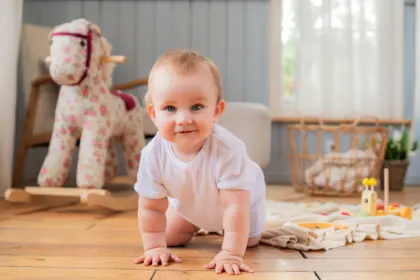0 - 3 Months
I can start to experience the world around me.
- Engage Their Senses: Talk to your baby, sing lullabies, and play soft music. Let them feel different textures like soft blankets or gentle toys. This sensory engagement helps stimulate their brain development and creates a comforting environment. Understanding why your child’s brain is so amazing | GOV.WALES
- Eye Contact: Make eye contact during feeding and playtime to help them recognize and bond with you. This builds trust and emotional connection. https://youtu.be/2z1eOuksqug
- Calm Environment: Create a calm and soothing environment with gentle lighting and minimal noise to help them feel secure. A peaceful setting can reduce stress and promote better sleep patterns. Love and affection: 0 to 4 years | GOV.WALES
- Gentle Massage: Give your baby a gentle massage to help them relax and improve circulation. Baby Massage: A Practical Approach
- Visual Stimulation: Hang a mobile above their crib to provide visual stimulation.
- Skin-to-Skin Contact: Spend time holding your baby skin-to-skin to promote bonding and emotional security. Skin to Skin - Betsi Cadwaladr University Health Board

4 - 6 Months
I can start to explore my surroundings.
- Exploration: Provide safe objects for them to touch and explore, like soft toys or teething rings. This encourages their curiosity and helps develop their fine motor skills.
- Outdoor Time: Take short walks outside to let them experience different sights, sounds, smells, and textures. Fresh air and natural light are beneficial for their health and can improve mood. Out and About link
- Facial Expressions: Use exaggerated facial expressions and sounds to capture their attention and encourage interaction. This helps them learn about emotions and social cues. https://youtu.be/2z1eOuksqug
- Tummy Time: Encourage tummy time to strengthen their neck and shoulder muscles. tummy_time_card_bilingual.pdf
- Water Play: Let them splash in a shallow basin of water to explore the sensation of water.
- Reading Aloud: Start reading simple board books to your baby to introduce them to the rhythm and sounds of language. Talk with me —Speech, Language and Communication (SLC): Delivery Plan 2020-2022

7 - 9 Months
I can start to interact more with my environment.
- Interactive Play: Play peek-a-boo and other interactive games to help them understand object permanence. These games are not only fun but also crucial for cognitive development. Tips for talking | HENRY
- Textures and Sounds: Introduce toys that make sounds or have different textures to stimulate their senses. This variety can enhance their sensory processing abilities.
- Mirror Play: Let them look at themselves in a mirror to help them recognize their own reflection. This activity supports self-awareness and visual recognition.
- Finger Foods: Introduce safe finger foods to encourage self-feeding and exploration of different tastes. Introducing solid foods - Betsi Cadwaladr University Health Board
- Music Time: Play different types of music and encourage them to move to the rhythm. YoungMinds
- Sensory Bags: Create sensory bags filled with different materials like rice, beans, or water beads for them to explore.

10 - 12 Months
“I can start to become more mobile and curious.”
- Exploration: Encourage crawling and exploring safe areas of your home. This physical activity is essential for muscle development and coordination. Every Child Newborn to age 2
- Naming Objects: Start naming objects and people around them to build their vocabulary. Early language exposure is key to developing communication skills. Talk with me —Speech, Language and Communication (SLC): Delivery Plan 2020-2022
- Routine: Establish simple routines to help them feel secure and understand what to expect. Consistent routines can provide a sense of stability and comfort. Seven steps to creating a successful baby routine | BabyCentre
- Stacking Toys: Provide stacking toys to help them develop hand-eye coordination.
- Sensory Bins: Create sensory bins with different materials like rice, beans, or sand for them to explore.
- Interactive Books: Use interactive books with flaps and textures to engage their curiosity and develop fine motor skills. Bookstart | BookTrust